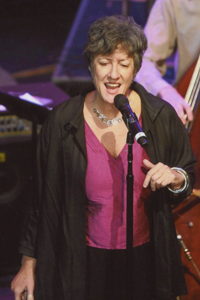Don't see what you're looking for?
Main Site
Berklee.eduCampuses and Schools
Ruthie Ristich
For media inquiries, please contact Media Relations
- Instruments include piano, voice, and electric bass
- Private voice teacher; adjunct voice faculty at Boston Conservatory
- Bandleader for jazz and popular performances in the U.S., England, Italy, Yugoslavia, Croatia, and Slovenia
- Vocalist/lead singer with a wide range of bands and orchestras; background vocalist with groups including vocal trio the Sisters of Swing and the Ritz
- Choral singing in groups ranging from three-part vocal swing jazz to a 24-voice chamber group, jazz choirs, and large ensembles singing masterworks
- Performed/appeared with Tim Ray, Brad Hatfield, Gaye Tolan-Hatfield, Roberta Radley, Bill Brinkley, Rick McLaughlin, David Clark, Wall of Respect for Women Choir, Bob Patton, Russ Gershon, John Pierce, Ben Wittmann, Alain Mallet, and Mike Rivard
- Media production includes electronic press kit videos for jazz musicians Danilo Perez and Catherine Russell, video projects for non-profits, family history mixed media, and legacy recordings for the elderly
- Recordings include: Carefully Taught, Mood Indigo with the Sisters of Swing and Swing-a-Jing-a-Lingin' (Roberta Radley featuring the Sisters of Swing). Produced Between the Worlds by Marcia Feldmann, Creature of Habit by Brian Ales, and various studio projects
- Educated/trained in classical voice pedagogy, jazz and pop methods, Jeanne LoVetri Somatic Voicework method, and body-mind wellness including movement and dance, Alexander technique, and Feldenkrais
- M.A., Harvard University Extension School, Department of Visual and Environmental Studies (VES), film/digital media
- B.M., Berklee College of Music, vocal performance
“I like to prepare my ear training students to learn and use all the tools in a well-equipped toolbox. It is so important to know how to use those tools—to understand what you’re hearing and to be able to write it down. Knowing how to communicate musically with a pianist or a small band will help you gain their respect. They may respect that you can be this killer singer, but if you don’t know when to come back in, or you don’t know the tempo, the groove, or the feel of the song, musicians’ eyes just glaze over. I’ve seen it happen. And if you can communicate to musicians using the right vocabulary, they’ll know what to play without wasting a lot of time.
“We identify intervals, chords, melodies, and rhythms through repetition, familiarity, and shared experience. Part of the fun in my classroom is making connections between the musical examples I bring in from all over the world and the curriculum; we listen and pick out recognizable tidbits that relate directly to the workbook materials—helping make it real. And to help students feel a kinesthetic relationship to the notes, I expect my students to conduct every musical example we sing in class.
“Lately I’ve been digging up my Berklee journals to share excerpts with my freshman seminar students, who have to keep a journal. I just re-read the entry about hiring my ear training professor as a sax player for my first gig. I started hiring professors for my gigs because I wanted to work with really good professionals. Working with people who have more experience, or who are better than you, is how you get better.
“My mantra is "don’t settle for less." Put in the effort to make whatever you do the absolute best it can be. Even if it’s just performing an eight-bar melodic example, I tell my students to make it as musical as possible and give it some passion—like it’s an audition for something you want more than anything. If you apply yourself in that way in everything you do, the world opens up for you.”
